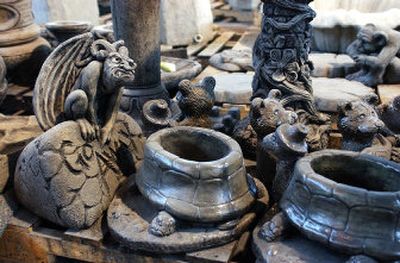Concrete lawn sculpture an art form

Arturo Morando was a 7-year-old in Mexico when his parents sent him to a local artisan to see whether the old man would teach the boy a trade.
“Yes,” said the artisan, Rodolfo Torres. He would, but only on the condition that Morando work with him daily. To an American child, to American parents, this kind of arrangement is foreign, but for the Morandos this agreement was the ticket to a good life, ensuring that their youngest son would have work, literally until he died.
“I liked it,” Morando says, smiling. “I was the only one in my family who got to leave home.” And leave home he did.
He’s 46 years old now and works in a sanitized studio in Spokane Industrial Park shaving, carving and chiseling foam and clay into just about anything. Anything, that is, that goes well with Kentucky bluegrass, lava rocks or beauty bark.
Morando sculpts lawn ornaments and fountains for Concrete Works Statuary. His work is on display at 205 S. Pines Rd. Nearly everything the company sells is crafted by Morando. He does the animals, bird baths and benches of the traditional variety, plus convincing replicas of the hexagonal volcanic spires so common to the Palouse. It is art displayed in a gallery so commonplace that few people ever consider who made it. Morando would insist it is art nonetheless.
“Not many people know this kind of art because most people, if they think of art, they think Italy or France, but this is art.”
As he speaks, he brushes latex, thin layer upon thin layer, over a fountain blank in the image of a Palouse spire. His studio is a dust-free, brightly lit room with vanilla walls and transoms 12 feet overhead. The latex, he explained, will not stick if there is dust in the air. Morando works silently, interrupted only by the music of the Everly Brothers playing on a tired AM radio.
“Arturo is an artist, you can see that in the detail of everything he does,” said Curtiss Grenz who owns Concrete Works Statuary with his wife, Laura.
He found Morando in California through business connections. Admittedly, Grenz owes a great deal of his success to Morando. When the owner started out, he had bought enough molds for two birdbath styles, two rabbits and two baskets. The business was part of a plan to return home to Spokane Valley from Northern California, where he ran a distribution center for McDonald’s. Grenz poured the statues himself in his parent’s backyard in the beginning, then sold the statues on the curb in front of Evergreen Lighting on Sprague Avenue.
Many of the sculptures Grenz sells are copyrighted and Morando cranks out enough designs to keep a small army busy.
Outside Morando’s immaculate studio is a forest of bears, roosters, gargoyles and hexagonal spires frozen in concrete. Some sculptures wear the expressions of happy simpletons, some scowl and others, like the troupe of tall cranes on spindly legs of rebar, strike elegant poses with their long necks.
Each of the figures was formed in a large latex sock encased in a fiberglass cast. The casts are tipped upside down and filled from the bottom with runny cement that’s strengthened with bits of fiberglass stubble. Casts are poured, and then left to sit for days until the cement hardens.
The east end of the shop is filled with a dozen or so sculptures waiting to be freed, which occurs every Wednesday when six or eight workers with socket bits and power drills unbutton the molds. The whir of power tools is endless.
Once the fiberglass tombs are set aside, the workers husk the latex membranes enveloping the cement sculptures. It is like watching pod people being born. The statues emerge slightly damp and still warm to the touch because the chemical process that hardens the cement still isn’t finished. As soon as the membranes are off, the crew of mostly Hispanic workers begins scraping stray flecks of stone from the membranes, which will be refilled with cement as soon as possible.
Not every statue comes into the world whole. Some arrive with birth defects, unwanted extra lines or crevices. A trio of men works in a corner, grinding or patching what imperfections they can. The statues have to be perfect, said the artisan from Mexico, or they’re not worth the trouble.
“Everything I do is with my heart,” Morando said. “If it’s worth making, then I want it to be the best.”